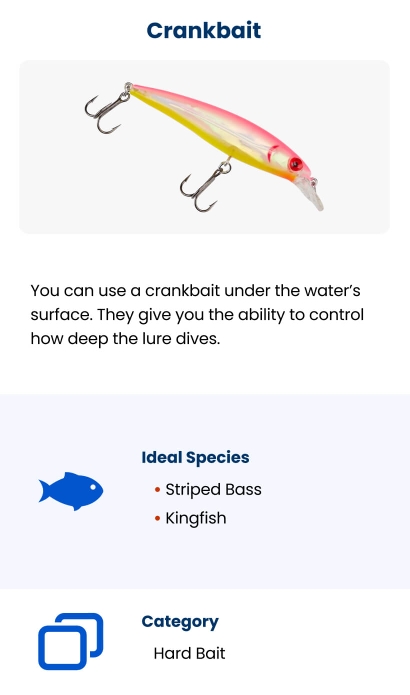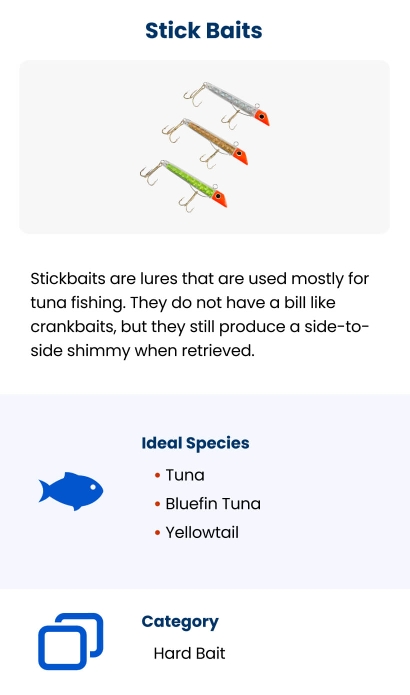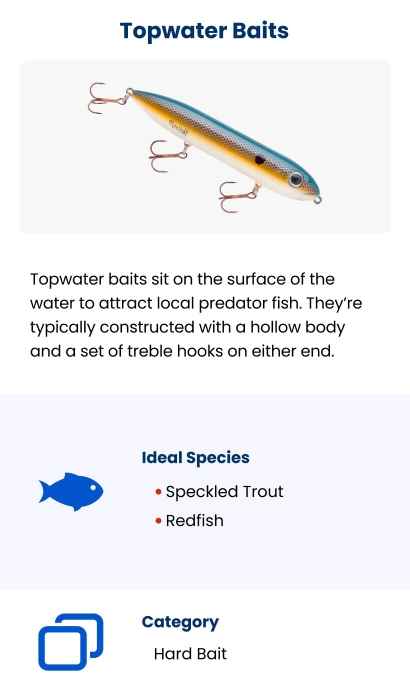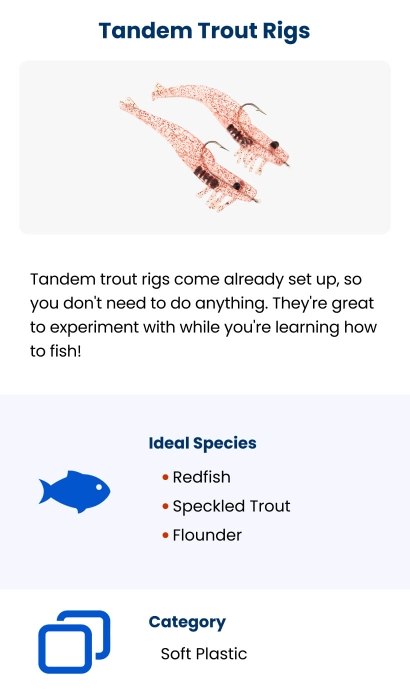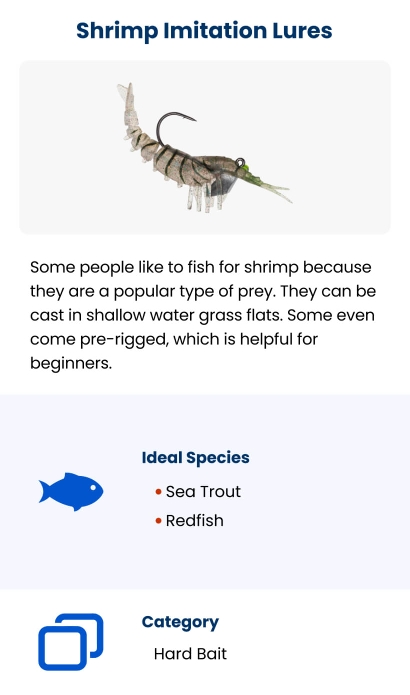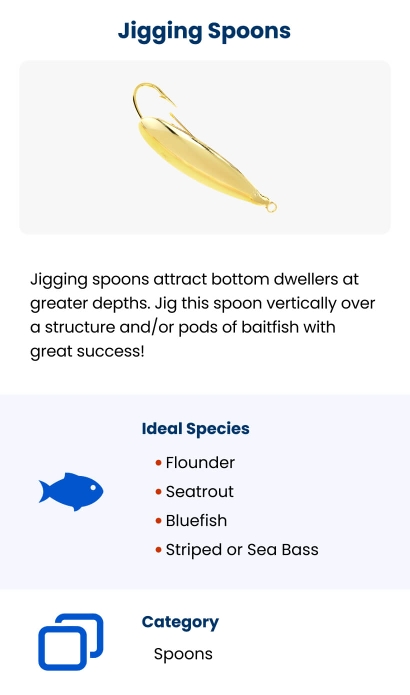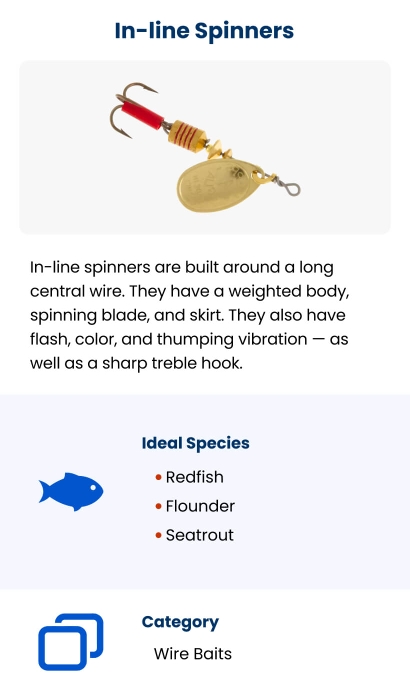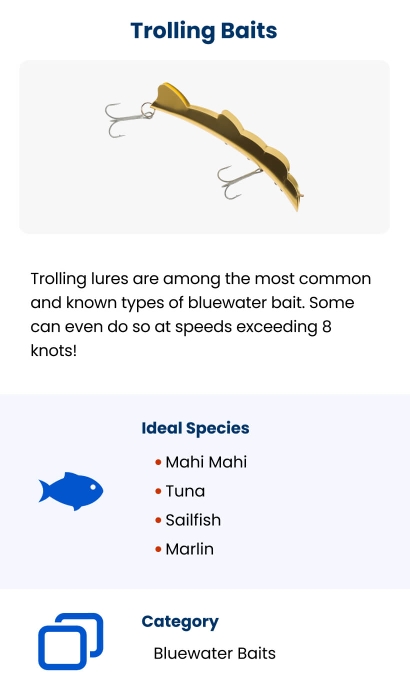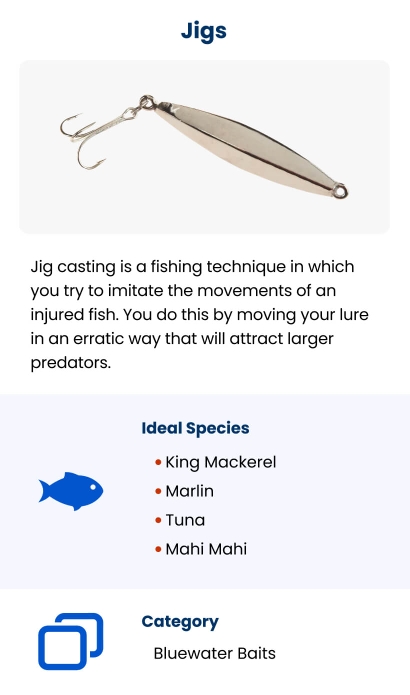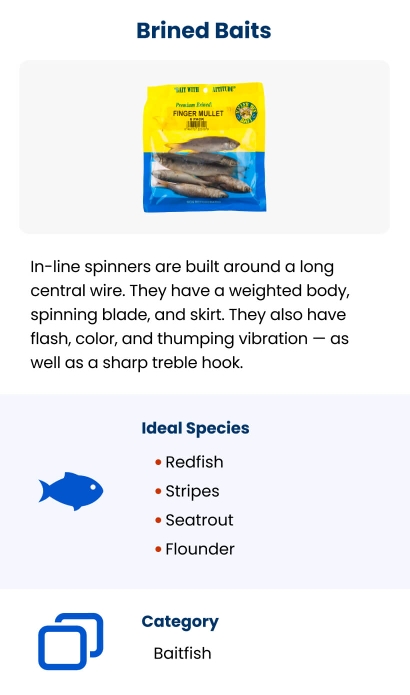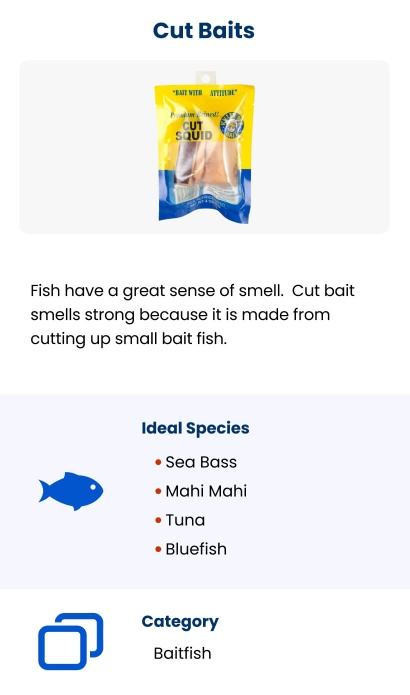17 Best Saltwater Fishing Lures & Baits That Work
Best Saltwater Lures & Baits To Have
There’s bait or a lure for every saltwater fish species and casting strategy out there. Don’t be afraid to stock up on a variety of options. You’ll be able to adapt your retrieval techniques as you need to. Keep reading this guide so you never leave behind that big catch!
Saltwater Fishing Lure Types Chart
Hard Bait
Hard baits look and behave like injured live bait with different actions — like topwater lures that splash. Many types of hard bait saltwater lures are built to float when you cast but dive once retrieved.
-
Paired with their heavier weight, this helps them avoid tangling in rocks, weeds, and other flotsam.
-
Hard lures allow for longer casts. This is especially useful in clear and calm waters when you need to keep your distance.

Crankbaits
If there’s ever a time to be dramatic and the center of attention, it’s when you fish with a crankbait lure! Crankbaits have a longer and wider bill, which allows them to dive to greater depths. The type of bill also dictates the lure’s action.
-
These lures vibrate, wobble, roll, and swim slowly to cover large areas in the water column.
-
They are generally shorter, wider, and rounder than other types of saltwater hard bait lures.
-
They also tend to have two hooks.
Expert Tip:
Match your line to your lure as the line size and diameter influence your crankbait depth and action. Use a rod with a generous bend at the tip to help produce enough action.
Rattle Traps (or Rat-L-Traps)
Rattle traps (also called lipless crankbaits) are versatile hard-body lures that make lots of noise in the water.
-
Their noise is great for fishing in murky waters or around big structures like docks and pier pilings.
-
Aggressive and restless fish find these lures irresistible because the noise further provokes them.
Expert Tip:
Cast out a lipless crankbait when the water is cool (between about 45-60 degrees Fahrenheit) in the spring and fall.
Stick Baits
Stickbaits are lipless, streamlined lures predominantly used in tuna fishing. Because they lack the bill of a crankbait, stickbaits produce a side-to-side shimmy when retrieved at a steady pace.
-
The hefty size and weight of stickbaits are especially useful when casting long throws, even in windy conditions.
-
Some of the largest and heaviest casting lures, stickbaits can top lengths of 12 inches.
-
When they’re in motion, stick baits will hover just beneath the water’s surface, and with experience, you can soon replicate most fish movements.
Expert Tip:
Bigger isn’t always better. Although you may be tempted to buy the largest lure, we think a 6-inch stick bait is best for beginners as it attracts a majority of game fish.
Jerk Baits
Jerk baits (also known as twitchbaits) are long and slender lures with treble hooks. These lures can produce a wide range of actions that replicate live baitfish movements:
-
Swimming
-
Darting
-
Rolling
-
Side-to-side motion
-
Twitching
-
Wiggling
Expert Tip:
They’re perfect for inshore fishing in shallow waters (typically in depths between one and six feet).
Topwater Baits
Topwater baits sit on the surface of the water to attract local predator fish. They’re typically constructed with a hollow body and a set of treble hooks on either end. Use a variety of strategies to manipulate the motion of topwater baits.
-
‘Walking the dog’ is a favorite strategy among anglers. Simply pop your rod to ‘walk’ the lure from side-to-side on top of the water (as opposed to being reeled in underneath the surface).
-
Topwater lures are great for cloudy weather and calm water scenarios. Fish feed at the surface and are more likely to hear and feel the vibrations of a lure.
Soft Bait (or Soft Plastics)
Soft bait lures (also known as soft plastics) are available in a multitude of shapes, patterns, and colors. You can also rig them in several ways. Target a wider variety of species in almost any location!
-
They are most often made from rubber or silicone. Bright colors are best for sunny days while darker hues present better against darker skies.
-
Although soft baits can be slow-rolled along the bottom, bounced, and cast, they usually perform best when worked more slowly and subtly than with your rod than hard baits.

Tandem Trout Rigs
Tandem trout rigs come pre-rigged, so they’re set up and ready to use. They’re great to experiment with as you learn to fish! Rig up multiple colors to identify what’s working.
-
They offer a slower fall rate than single baits because the weight is split.
-
Their double profile also mimics schooling baitfish, which is appealing.
-
Their core benefit lies in that they offer a double bait appeal.
Shrimp Imitation Lures
Shrimp is a popular inshore prey. So it makes sense why so many fishers love using shrimp imitation lures! Available in a variety of designs, shrimp lures are incredibly versatile.
-
A great place to cast them is in shallow water grass flats.
-
Some shrimp lures even come pre-rigged, which is helpful for beginners.
Expert Tip:
Shrimp imitation lures pair well with popping corks. While these corks aren't really fishing bait, they are essential for imitating the noise and commotion that live shrimp make when there is a predator nearby.
Spoons
Spoons are concave metal lures that flash like swimming fish. The flash entices a quick strike from aggressive predators. One end of the spoon is usually wider than the other. Its unique shape usually wobbles in the water.
-
They’re available in a variety of sizes, shapes, and finishes to match whatever kind of bait fish are in the area.
-
Easy to learn and use as well as simple in design, they’re one of the most universal types of saltwater fishing lures.

Casting Spoons
Casting spoons are the heavier and denser of the two main types of spoon lures. They cast further in distance and work great when you’re wanting to imitate small bait. Anytime you’re in an unfamiliar area, they make a wonderful prospecting lure!
Trolling Spoons
Trolling Spoons can withstand both high and slow speeds. If you’re trolling a spoon behind a weight, make sure to use a long leader to keep them separate. The heavier the sinker, the deeper or faster the troll.
Jigging Spoons
Jigging Spoons bounce deep at the floor to attract bottom dwellers (like seatrout, seabass, and bluefish) at greater depths. You can also jig a spoon vertically over a structure and/or pods of baitfish with much success.
Wire Bait
Wire baits rely on parts that spin, vibrate, and flash to attract wandering fish. They’re commonly used as search baits that can cover a lot of water. They are also effective in shallow water! They work great when you want to lure in slower fish.
-
They’re available in many different designs, colors, and hook and wire bends. Each variation is suitable for a particular type of species of fish and in specific environments.
-
A bent lure will have impaired balance! Always make sure to check they’re still spinning properly every few casts.

Spinnerbaits
Simply reeling in a spinnerbait produces action that leads to a strike. These lures are not as versatile nor are they as successful in crystal-clear waters and calm conditions as say spoons. They have a bent-wire design that places the hook opposite of the spinning blades. This setup offers a bigger presentation.
In-Line Spinners
Builts around a long central wire, in-line spinners have a weighted body, spinning blade, and skirt. They still have plenty of flash, color, and thumping vibration — as well as a sharp treble hook.
All of this works together to attract a variety of fish in murky waters and/or near weed beds and other obstacles. Its weight is nicely centered. Beginners will find that in-line spinners make for accurate and easy casting.
Bluewater Bait
Bluewater baits (also called offshore lures) are perfect trolling lures for water at depths between 20–40 feet. Easily attract and catch large saltwater game fish like tuna, Mahi Mahi, and grouper and more a mile from shore.
-
Because they’re used in harsher conditions, they usually have hard bodies and heavy-duty steel hooks.
-
They also feature large plastic lips that aid in deep dives.
-
Most fishing with bluewater baits happens near offshore rigs, shipwrecks, and coral reefs.

Trolling Lures
Trolling Lures are among the most common and known types of bluewater bait. They’re perfect for attracting kingfish, tuna, and wahoo to your line. Some can even do so at speeds exceeding 8 knots! Common fish-attracting actions you’ll find for trolling bait can include:
-
A side-to-side zig-zag
-
A rotation that triggers a wide flash
-
A lifelike appearance and behaviors
Jigs
Jig casting is a method of fishing that relies heavily on recreating specific movements identical to that of an injured baitfish. These movements result in a jig lure’s action that is erratic and alluring to large predator fish.
-
You’ll often find just lures that appear bright in color and soft to the touch.
-
These lures capitalize on moving AND appearing like those enticing baitfish your next big catch wants!
Baitfish
Whether it’s brined, frozen, cut, or live, baitfish attract a wide range of fish. Although you’ll need terminal tackle to keep the natural bait on your line, fishing with natural bait is relatively easy (albeit a bit messy).
Expert Tip:
Many fish hook themselves, so it’s not as necessary to know when to strike. Baitfish are perfect for beginners and casual anglers who want a less active experience.
Brined Baits
Brining is a method of preservation that extends the ‘life’ of dead bait for future use. You can buy brining mixtures and other fish attractants or make your own.
Cut Baits
Fish have an incredible sense of smell and cut bait has a strong aroma. Cut bait is exactly what it sounds like — bait made from cutting up smaller bait fish.
Live Bait
Some fish will only eat live bait. This can be anything from worms, leeches, and minnows to shellfish and grouper. You can catch your own live bait or head to a bait shop. Either way, you’ll need a way to keep your bait alive and fresh while out on the water.
-
Eels and ballyhoo are commonly used in saltwater big game fishing because fish are naturally drawn to movement.
-
Redfish love blue crabs, and mullets and live or frozen shrimp are a favorite of many species.
What’s the Difference Between Bait vs Lures?
Artificial lures are a part much broader category. ‘Bait’ encompasses a wide range of live, cut, frozen, or brined bait including all the types of artificial saltwater lures we’ve explored in this guide! Here are a few key differences:
Live Bait
- Kids and beginners
- Darker fishing conditions (at night, cloudy, and/or dark and muddy waters)
- Cold water
- Relaxing style of fishing
Artificial Lures
- More active style of fishing
- Clear water
- Warm, sunny weather
- More active/involved style of fishing
- Covering more water
Have Fun Out There!
Want to catch even more saltwater fish? Head to your local Academy Sports + Outdoors to speak with an expert in person. We’ll help you outfit your tacklebox with everything you need for your next adventure.
